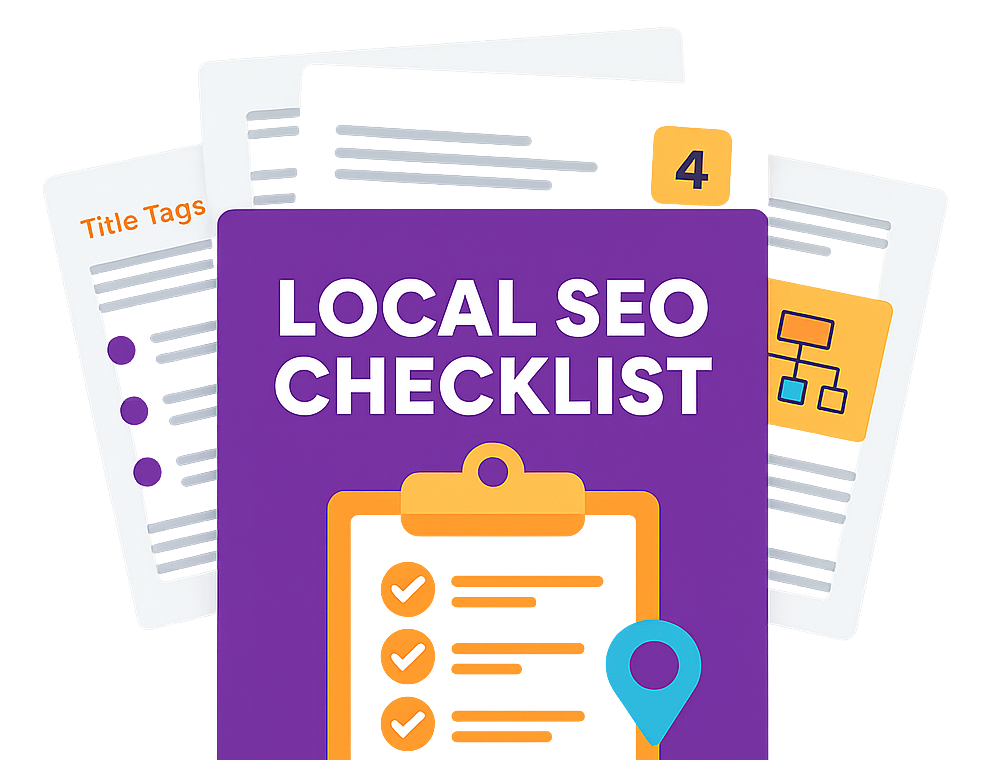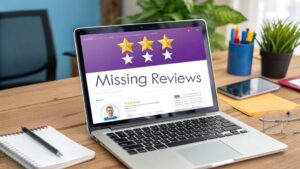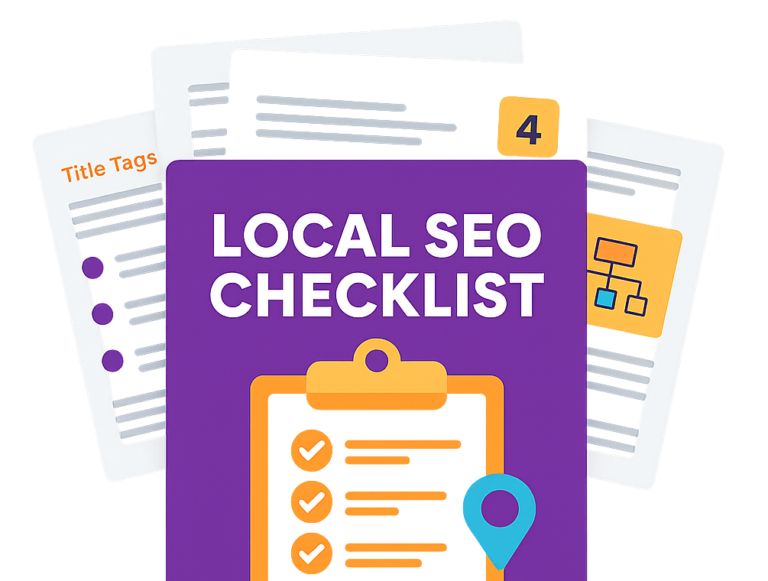Want to rank higher on Google? Forget about trying to game the system with complex tricks. The most effective way forward is surprisingly straightforward: create content that genuinely answers what people are looking for, make sure your website works flawlessly on a phone, and build it all on a solid technical base.
These are the things that really move the needle in modern SEO.
Your Foundation for Higher Google Rankings
Before you even think about advanced strategies or chasing the latest algorithm update, it's essential to get the fundamentals right. Nailing these basics makes every other effort you put in so much more effective. For any UK business, that means focusing on the principles that genuinely drive search performance today.
The biggest shift we've seen in recent years is the move away from just cramming keywords onto a page. Now, it's all about understanding user intent—the 'why' behind someone's search. Are they just after information, are they ready to buy, or are they comparing their options? Aligning your content with that intent is the single most powerful thing you can do.
Focus on Mobile-First Optimisation
Let's be clear: optimising your website for mobile isn't just a good idea anymore; it's a must-do. Google now commands a staggering 97.54% of the UK mobile search market, and since they finalised their mobile-first indexing in 2023, the mobile version of your site is the only one that matters for rankings.
A slow, clunky mobile experience is a direct route to the bottom of the search results.
I see this all the time: a business owner assumes their beautiful desktop site works just as well on mobile. You have to test it on an actual smartphone. Can you easily read the text? Can you navigate without pinching and zooming? If the answer is no, you’ve got work to do.
Understand Your Core Pillars for Better Google Rankings
To build a strategy that lasts, it's best to concentrate on the three areas that will give you the biggest bang for your buck. I've summarised them here to give you a clear starting point.
| Pillar | Why It Matters for UK Businesses | Your First Actionable Step |
|---|---|---|
| User Intent | Matching your content to what users are actively searching for proves your relevance and value to Google. | Look at the top-ranking pages for your main keywords. What questions do they answer? What format is the content in (e.g., a guide, a list, a product page)? |
| Mobile Experience | With most UK searches happening on mobile, a seamless mobile site is non-negotiable for high rankings. | Use Google's PageSpeed Insights to test your site's mobile speed and usability. Fix any issues it flags, starting with the most critical ones. |
| Local Presence | For many small businesses, showing up in local search results drives footfall and brings in high-quality leads. | If you serve local customers, your foundation must include a strong presence on Google Maps. Start by getting your business on Google Maps to attract clients in your area. |
By making these foundational elements—user intent, mobile performance, and local visibility—your top priority, you create a powerful base. This ensures that when you do move on to creating more content or building links, your efforts will actually deliver much better and more lasting results.
Mastering On-Page SEO for Real Results

Now that you've got a solid technical foundation, it’s time to get your hands dirty with on-page SEO. These are the practical, page-by-page tweaks that tell Google exactly what your content is about and why it deserves to rank. The best part? You have complete control over every single element, which means it’s one of the fastest ways to see genuine improvements in your search rankings.
Think of each page on your website as having one specific job. Your goal is to make sure it does that job perfectly, both for the people visiting and for the search engines crawling it. This covers everything from the words you choose to how you lay out your information.
Crafting Titles and Descriptions That Earn Clicks
Your title tag and meta description are your virtual shop window in the search results. They’re often the very first impression a potential customer gets of your brand, and they can make or break their decision to click.
A great title tag needs to be compelling, but it absolutely must include your main keyword, ideally near the start. This gives Google and the searcher an instant signal that your page is relevant. For instance, a title like "Plumbers in Cambridge | Emergency Boiler Repair & Service" is leagues better than a vague "Our Services".
The meta description, on the other hand, is your 155-character sales pitch. While it doesn't directly affect your rankings, it has a massive influence on your click-through rate (CTR). A higher CTR is a strong signal to Google that your page is a great match for a query, which can indirectly boost your rankings over time. Use this space to summarise the page’s value and pop in a clear call to action.
Structuring Content for Readability and Relevance
How you organise the content on your pages is massively important. Google looks closely at headings (H1, H2, H3, and so on) to understand the structure and key topics of your page. A poorly structured page isn't just hard for people to read; it's a nightmare for search engines to index properly.
Every single page should have one—and only one—H1 tag. This is your page's main title, and it needs to sum up the entire page's purpose. Think of it as the title of a book.
Your H2 and H3 headings then act as the chapter titles and subheadings, breaking the content into logical, bite-sized chunks. This makes a huge difference to the user experience, especially since most people skim online content. Good structure helps them find what they need without feeling overwhelmed.
A simple but powerful tip is to treat your headings like an outline. If you were to read only the H1, H2s, and H3s, you should get the gist of the entire page. That’s pretty much how Google's crawlers try to make sense of your content, too.
The Power of Smart Internal Linking
Internal linking—the simple act of linking from one page on your website to another—is a seriously underrated SEO tactic. It’s a powerhouse that achieves three critical goals to help you rank higher on Google:
- It helps search engines find your pages: When Google crawls a page, it follows the links on it. A good internal linking structure ensures all your important pages get discovered and indexed.
- It spreads authority across your site: If you have a popular blog post that’s getting a lot of attention, linking from it to a relevant service page passes some of that "link juice," giving the service page a ranking boost.
- It guides users where you want them to go: Smart internal links help visitors find more useful information, keeping them on your site longer and nudging them towards your contact forms or service pages.
For example, if you write a blog post about "How to Choose a New Boiler," it’s a no-brainer to link to your "Boiler Installation Service" page within the article. It’s helpful for the reader and clearly signals the relationship between your content to Google.
Staying on top of best practices is crucial, and keeping an eye on current SEO trends for 2023 will give you an edge. By mastering these on-page elements, you can turn every page into a finely-tuned asset that actively works to improve your visibility.
Creating Content That Google and Customers Value

While all the technical fixes and on-page tweaks set the stage, it's your content that does the heavy lifting. This is what ultimately convinces both Google and your customers that your site is worth their time. Think of it this way: your on-page SEO is the well-organised shop front, but your content is the actual product people came for.
In the old days of SEO, it was all about keyword density and pumping out as much content as possible. That game is long over. Today, the focus has shifted entirely to quality, relevance, and helpfulness.
The most important question you can ask yourself is: "Does this piece of content genuinely solve a problem or answer a question for my audience?" If the answer is no, it's just not going to rank well in the long run. Simple as that.
Moving from Keywords to Topics
One of the biggest mindset shifts you need to make is moving away from a narrow keyword-first approach to a broader, topic-focused one. Instead of creating ten flimsy articles trying to catch minor keyword variations, the smart strategy is to build one comprehensive, authoritative piece that covers a topic from top to bottom.
Let's say a Cambridgeshire-based catering company used to write separate, thin posts for "wedding catering costs," "event food ideas," and "corporate lunch menus." The modern, and much more effective, approach is to create a single, in-depth guide like "The Ultimate Guide to Event Catering in Cambridgeshire."
This one resource can then be structured with clear subheadings (H2s and H3s) that tackle all those smaller queries within a single, logical article. This signals to Google that you're an authority on the whole topic, not just a handful of keywords.
Your goal is to become the go-to resource for your niche. When someone lands on your page, they shouldn't need to hit the 'back' button to find more information. Your content should provide the complete answer, building trust and signalling huge value to Google.
Understanding and Answering User Intent
Every search has an underlying "intent"—the real reason someone is typing into that search bar. Nailing this is non-negotiable. Generally, search intent falls into four camps:
- Informational: The user wants to learn something (e.g., "how does a heat pump work?").
- Navigational: They're looking for a specific website (e.g., "Bare Digital SEO").
- Commercial: They're researching before a purchase (e.g., "best accounting software for small business UK").
- Transactional: They're ready to buy right now (e.g., "buy Nike Air Max size 9").
To rank, your content format must match the user's intent. If someone searches for "emergency plumber Cambridge" and lands on a blog post, they're going to leave instantly. They expect a service page with a phone number. On the other hand, someone searching "how to fix a leaky tap" wants a helpful guide or video, not a hard sales page.
The Impact of AI on Content Quality
Technology is always changing the game, and AI is no exception. Google's algorithm, powered by its own AI and natural language processing, now heavily rewards high-quality content that directly answers what a user is looking for. For businesses in the UK, this has turned SEO from a keyword-stuffing chore into a mission to create genuinely helpful, user-focused content.
AI can also be a useful assistant in this process. For marketers wanting to use it smartly, exploring resources like these diverse ChatGPT prompts tailored for digital marketers can be a great way to kickstart ideas and build outlines.
What's more, with conversational voice searches expected to make up about 50% of all searches soon, your content needs to speak in a natural, human way. Google's updates consistently favour content that solves real-world problems, reinforcing why UK businesses need to double down on authenticity and helpfulness.
Practical Tips for Creating High-Value Content
Putting all this theory into practice is what separates the sites that rank from those that don't. Here are a few actionable tips to get you started:
-
Solve a Real Problem: Don't just write about your services. Think about the tangible problems your customers have and create content that solves them. A financial adviser could write a guide on "Creating Your First Budget After University," offering genuine value long before pitching their services.
-
Use Varied Formats: Not everyone wants to read a 2,000-word article. Mix it up to keep your content engaging and useful.
- High-quality images to break up text and illustrate points.
- Short video tutorials to explain complex processes.
- Infographics to make data easy to digest.
- Downloadable checklists or templates to provide a practical tool.
-
Write for Skimmers: Let's be honest, most people don't read online; they scan. Structure your content so it's easy to skim. Use short paragraphs, clear subheadings, bullet points, and bold text for key takeaways. This makes for a much better user experience and helps Google quickly understand what your content is all about.
By consistently creating content that is comprehensive, matches user intent, and is genuinely helpful, you build a powerful and lasting foundation for ranking higher on Google.
Getting to Grips with Technical SEO
Technical SEO is the engine humming away behind the scenes. It might not have the glamour of slick content or big-name backlinks, but it’s the non-negotiable foundation your entire SEO strategy is built on. Get this part wrong, and even the most brilliant content will get lost in the digital noise.
I’ve seen many business owners get a bit intimidated by the term "technical," but it’s more straightforward than you might think. At its core, it's about making sure your website is fast, secure, and dead simple for search engines to understand. These are the fundamental signals Google uses to gauge quality and trustworthiness.
Prioritise Blazing-Fast Site Speed
A slow website is a certified ranking killer. It’s no secret—Google has openly confirmed that site speed is a direct ranking factor, especially for mobile searches where users have zero patience. A lag of just a few seconds is all it takes for a potential customer to hit the back button and go straight to a competitor.
Getting your website speed up to snuff through professional WordPress speed optimisation is one of the best investments you can make. It’s not about fiddling with one or two settings; it’s a holistic approach that looks at everything from image sizes to server response times.
The usual suspects slowing down sites are often the same:
- Unoptimised images: Giant, high-resolution photos are the number one culprit I see. They look great but drag page load times down.
- Bloated code: Messy CSS, JavaScript, and too many plugins can bog down your site's performance, creating a clunky experience.
- Slow web hosting: That cheap shared hosting plan might save you a few quid upfront, but it could cost you dearly in lost rankings and customers down the line.
You can get a quick health check on your site’s speed with free tools like Google's PageSpeed Insights. It gives you a clear score for mobile and desktop and points out specific problems, like oversized image files or clunky code that needs cleaning up.
Make Your Site Easy for Google to Crawl
Before Google can even think about ranking your content, it has to find and understand it first. This process is known as crawling and indexing. A logical site structure, along with a couple of key files, makes this process a walk in the park for search engine ‘spiders’.
Your website's structure should be as intuitive as a well-organised shop. A new visitor—or a Googlebot—should be able to get from your homepage to any important page in just a few clicks. This is usually managed with a clear navigation menu and smart internal linking.
Think of it this way: if a new visitor can't easily find your main service pages, neither can Google. A confusing structure sends a negative signal about user experience, which can directly harm your efforts to rank higher on Google.
To help Google map out your site, two files are absolutely essential: an XML sitemap and a robots.txt file.
- An XML Sitemap is just a list of all the important pages on your website, created specifically for search engines. It’s like giving Google a roadmap to ensure it doesn’t miss any of your valuable content.
- The Robots.txt file gives search crawlers instructions on which parts of your site they should or shouldn't look at. For instance, you’d typically block them from crawling admin pages or temporary files.
Nailing these technical elements is critical. For a more detailed look, our technical SEO audit checklist provides 15 essential elements to help you get your site into top shape. When you build a fast, secure, and crawl-friendly website, you're creating the perfect launchpad for your content to shine and climb the search rankings.
Building Authority with High-Quality Backlinks
Backlinks—those links pointing from other websites to yours—are still one of Google's biggest clues for figuring out trustworthiness and authority. Think of them as digital word-of-mouth. When a high-quality, relevant site links to you, it’s like a solid recommendation, telling search engines your content is the real deal.
But the game has changed. It's no longer a race to collect as many links as you can from anywhere you can. These days, quality trumps quantity, every time. Honestly, a single, powerful link from a respected UK industry journal is worth far more than a hundred dodgy links from irrelevant directories.
Let’s walk through some realistic, ethical strategies for earning valuable backlinks that will actually help you climb the Google rankings.
Focus on Earning Links, Not Just Building Them
The best backlinks are the ones that come to you naturally because you’ve created something genuinely useful. To get there, you need to create 'link-worthy' assets—content so good that other creators, journalists, and bloggers want to reference and link back to it.
Here are a few types of content that consistently attract links:
- Original Research & Data: Run a survey on a local issue, analyse industry trends, or publish unique findings. Journalists and bloggers are always hungry for fresh stats, and they'll happily link back to you as the source.
- Comprehensive Guides: Create the go-to resource on a topic that matters to your business. A local financial adviser, for instance, could publish "The Ultimate Guide to First-Time Home Buying in Cambridgeshire."
- Free Tools & Calculators: Offer something genuinely practical, like a mortgage calculator or a project cost estimator. These tools are incredibly useful and get linked to over and over again.
The infographic below shows just how much the authority of the linking site matters.

As you can see, putting your energy into getting links from sites with high domain authority gives your Google rankings a much bigger boost.
Of course, once you have a fantastic asset, you can't just sit back and wait. You need to let the right people know it exists. This is where targeted outreach comes in. Find relevant UK publications, industry blogs, and even local journalists who cover your niche. Send them a polite, personalised email showing them your content and explaining why it might be valuable to their audience.
For a more in-depth look at doing this effectively, you can learn how to build backlinks with proven strategies that actually work.
Ethical Backlink Strategy Comparison
Not all link-building tactics are created equal. Some require more legwork than others but can deliver a much bigger payoff. Here’s a quick comparison of some effective, white-hat strategies to help you decide where to focus your efforts.
| Tactic | Effort Level | Potential Impact | Best For |
|---|---|---|---|
| Guest Posting | Medium | High | Building authority and reaching new audiences in your niche. |
| Creating Linkable Assets | High | Very High | Businesses that can produce original research, guides, or tools. |
| Broken Link Building | Medium | Medium | Finding quick, relevant link opportunities on established sites. |
| Local Partnerships | Low | Medium | Local businesses wanting to strengthen community ties and local SEO. |
| Directory Listings | Low | Low-Medium | Establishing foundational local signals and credibility. |
Each of these methods has its place in a well-rounded strategy. The key is to choose tactics that align with your resources and goals, always prioritising quality and relevance over sheer volume.
Leverage Local Partnerships and Directories
If you're a business targeting a local UK market, your community is an absolute goldmine for backlink opportunities. Building genuine relationships with other local businesses is a fantastic way to earn natural, high-quality links.
Try a few of these local strategies:
- Sponsor a local event. Putting your name on a local charity run, a community fair, or a school fete usually earns you a link from their website's sponsors page. It’s good for the community and good for your SEO.
- Partner with non-competing businesses. A wedding photographer could write a guest post for a local venue's blog, sharing tips for perfect photos at their specific location—and get a valuable link back in return.
- Join local business associations. Organisations like your local Chamber of Commerce often feature member directories with links back to your website.
It's crucial to distinguish between high-value local directories (like the Chamber of Commerce or trusted industry-specific listings) and spammy, low-quality directories that exist only for SEO. The former builds authority; the latter can actively harm it.
Identify and Avoid Toxic Backlinks
Just as some links help, others can hurt. A toxic backlink is a link from a spammy, low-quality, or completely irrelevant website. These often come from old, black-hat SEO tactics you (or a previous agency) might have used, or they can just pop up without you doing anything.
A large number of these toxic links can flag your site to Google and potentially lead to a penalty, which can tank your rankings.
You should get into the habit of auditing your backlink profile every so often using tools like Google Search Console or Ahrefs. Keep an eye out for links from:
- Websites in a completely different language or country.
- Sites with strange or nonsensical domain names.
- Known spam sites or "link farms" designed purely to manipulate rankings.
If you do find a significant number of toxic links, you can use Google's Disavow Tool to ask the search engine to ignore them. But a word of caution: this tool should be used carefully, usually only after you've received a manual penalty notice in Google Search Console. For most small businesses, your time is much better spent building good links rather than obsessing over a few bad ones.
Your Top Google Ranking Questions Answered

Even with a solid SEO strategy in place, it’s completely normal for UK businesses to have questions about the finer details. Let's clear up some of the most common queries I hear, giving you straightforward answers to help you rank higher on Google.
A classic question is whether you need to pay for Google Ads to rank organically. The short answer is no. Paid ads and organic search are two separate beasts. While paying for ads won’t directly boost your organic rankings, it can be a fantastic source of data on which keywords convert best, giving you a head start for your content strategy.
Another point of confusion is how long it all takes. SEO is a marathon, not a sprint. While you might see small boosts from on-page tweaks within a few weeks, significant, lasting improvements typically take anywhere from four to 12 months of consistent work. Patience and persistence are your best friends here.
How Important Is Mobile SEO?
In short: it's everything. For nearly every UK business, mobile SEO isn't just a priority; it's the priority. Google’s mobile-first indexing means it primarily uses the mobile version of your site to figure out where you should rank. With most searches happening on phones, a fast, easy-to-use mobile site is non-negotiable.
While Google is king, its market share is always shifting. Recent UK data suggests that between August 2024 and July 2025, Google's share will likely settle at around 93.35%. This just reinforces the need for a strong Google-focused strategy, while also keeping half an eye on emerging AI platforms.
I’ve seen so many businesses fall into the trap of assuming their beautiful desktop site works just as well on mobile. You have to test it on a real smartphone. If it’s a pain to navigate, you’re not just losing rankings—you’re losing customers.
Getting the basics right can make all the difference. To put yourself ahead of the competition, it’s worth getting familiar with the 5 common SEO mistakes small businesses make to ensure you’re building on a solid foundation.
Frequently Asked Questions
We've covered a lot, but you might still have some specific questions buzzing around. Here are some quick-fire answers to other common queries we receive from business owners.
| Question | Answer |
|---|---|
| How many keywords should I target per page? | Focus on one primary keyword and a handful of closely related secondary keywords. This keeps your content focused and signals clear intent to Google. |
| Do I need a blog for SEO? | While not strictly mandatory, a blog is one of the most powerful tools for attracting traffic, building authority, and targeting a wide range of keywords. |
| Is it bad to have duplicate content? | Yes, it can dilute your rankings and confuse search engines. Use canonical tags to tell Google which version of a page is the original. |
| How often should I update my content? | For key pages, review and refresh them at least once a year. For blog posts, update them whenever the information becomes outdated to keep them relevant. |
Hopefully, that clears things up! The key is to stay informed, avoid common pitfalls, and be consistent with your efforts.








